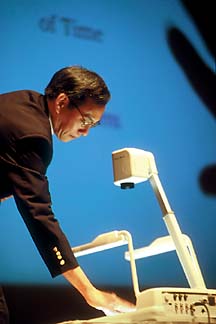
|
![[NEWS AND FACTS BANNER]](/URClipArt/misc/newsfacts.jpg) |
|||||||

Reveling in Contradictions
The academic field of quantum optics is more than 100 years old, and even Nobel Prize winners are still having trouble sorting out the implications. A subject that revels in seeming contradictions-light is both discrete photon and continuous wave; two atoms sharing a quantum state become the same atom -often forces logically minded scientists into seemingly illogical conclusions. When it was first proposed, the quantum theory "made no sense to anyone who thought about it in any rational way," admitted Nobel laureate Steven Chu '70 during a presentation in Strong Auditorium. "Physicists would have loved for it to go away." "We hate this theory," he added. "The only thing it has going for it is that it seems to be true." Chu, a professor of physics at Stanford University, is one of the most highly regarded specialists engaged in deciphering the quirky, subatomic boundary where light and matter interact. Joined on stage by University optics professor Ian Walmsley and physics professor Nick Bigelow, Chu outlined some of the work for which he won the 1997 Nobel Prize in physics. Using focused laser light, Chu proved that the motion of atoms could be brought to a near standstill, effectively cooling the atoms to a fraction of a degree above absolute zero. Such atoms are trapped in what Chu calls "optical molasses." This technical breakthrough has resulted in some unforeseen but important applications. In particular, the work has contributed to the development of hyper-accurate clocks that lose only fractions of a second over many millions of years. That, in turn, makes other measurements more accurate. "The measurement of time is the stake in the ground for all other measurements," he said.
Maintained by University Public Relations | ||||||||
